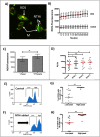Nontypeable Haemophilus influenzae induces sustained lung oxidative stress and protease expression
- PMID: 25793977
- PMCID: PMC4368769
- DOI: 10.1371/journal.pone.0120371
Nontypeable Haemophilus influenzae induces sustained lung oxidative stress and protease expression
Abstract
Nontypeable Haemophilus influenzae (NTHi) is a prevalent bacterium found in a variety of chronic respiratory diseases. The role of this bacterium in the pathogenesis of lung inflammation is not well defined. In this study we examined the effect of NTHi on two important lung inflammatory processes 1), oxidative stress and 2), protease expression. Bronchoalveolar macrophages were obtained from 121 human subjects, blood neutrophils from 15 subjects, and human-lung fibroblast and epithelial cell lines from 16 subjects. Cells were stimulated with NTHi to measure the effect on reactive oxygen species (ROS) production and extracellular trap formation. We also measured the production of the oxidant, 3-nitrotyrosine (3-NT) in the lungs of mice infected with this bacterium. NTHi induced widespread production of 3-NT in mouse lungs. This bacterium induced significantly increased ROS production in human fibroblasts, epithelial cells, macrophages and neutrophils; with the highest levels in the phagocytic cells. In human macrophages NTHi caused a sustained, extracellular production of ROS that increased over time. The production of ROS was associated with the formation of macrophage extracellular trap-like structures which co-expressed the protease metalloproteinase-12. The formation of the macrophage extracellular trap-like structures was markedly inhibited by the addition of DNase. In this study we have demonstrated that NTHi induces lung oxidative stress with macrophage extracellular trap formation and associated protease expression. DNase inhibited the formation of extracellular traps.
Conflict of interest statement
Figures




Similar articles
-
Nrf2 regulates chronic lung inflammation and B-cell responses to nontypeable Haemophilus influenzae.Am J Respir Cell Mol Biol. 2011 Sep;45(3):557-65. doi: 10.1165/rcmb.2010-0321OC. Epub 2011 Jan 7. Am J Respir Cell Mol Biol. 2011. PMID: 21216970 Free PMC article.
-
Mechanisms of clearance of nontypeable Haemophilus influenzae from cigarette smoke-exposed mouse lungs.Eur Respir J. 2010 Nov;36(5):1131-42. doi: 10.1183/09031936.00113909. Epub 2010 Apr 22. Eur Respir J. 2010. PMID: 20413532
-
PHiD-CV induces anti-Protein D antibodies but does not augment pulmonary clearance of nontypeable Haemophilus influenzae in mice.Vaccine. 2015 Sep 11;33(38):4954-61. doi: 10.1016/j.vaccine.2015.07.034. Epub 2015 Jul 26. Vaccine. 2015. PMID: 26212006
-
Novel concepts in nontypeable Haemophilus influenzae biofilm formation.FEMS Microbiol Lett. 2013 Sep;346(2):81-9. doi: 10.1111/1574-6968.12203. Epub 2013 Jul 15. FEMS Microbiol Lett. 2013. PMID: 23808954 Review.
-
Network of Extracellular Traps in the Pathogenesis of Sterile Chronic Inflammatory Diseases: Role of Oxidative Stress and Potential Clinical Applications.Antioxid Redox Signal. 2024 Aug;41(4-6):396-427. doi: 10.1089/ars.2023.0329. Epub 2023 Nov 7. Antioxid Redox Signal. 2024. PMID: 37725535 Review. No abstract available.
Cited by
-
The Expanding Role of Extracellular Traps in Inflammation and Autoimmunity: The New Players in Casting Dark Webs.Int J Mol Sci. 2022 Mar 30;23(7):3793. doi: 10.3390/ijms23073793. Int J Mol Sci. 2022. PMID: 35409152 Free PMC article. Review.
-
Moraxella catarrhalis evades neutrophil oxidative stress responses providing a safer niche for nontypeable Haemophilus influenzae.iScience. 2022 Feb 17;25(3):103931. doi: 10.1016/j.isci.2022.103931. eCollection 2022 Mar 18. iScience. 2022. PMID: 35265810 Free PMC article.
-
The "Self-Sacrifice" of ImmuneCells in Sepsis.Front Immunol. 2022 Apr 29;13:833479. doi: 10.3389/fimmu.2022.833479. eCollection 2022. Front Immunol. 2022. PMID: 35572571 Free PMC article. Review.
-
The role of NTHi colonization and infection in the pathogenesis of neutrophilic asthma.Respir Res. 2020 Jul 3;21(1):170. doi: 10.1186/s12931-020-01438-5. Respir Res. 2020. PMID: 32620122 Free PMC article. Review.
-
The role of extracellular traps released by neutrophils, eosinophils, and macrophages in asthma.Respir Res. 2024 Jul 30;25(1):290. doi: 10.1186/s12931-024-02923-x. Respir Res. 2024. PMID: 39080638 Free PMC article. Review.
References
-
- Murphy TF. Haemophilus infections In: Braunwald F, Kaspar, Hauser, Longo, Jameson, editor. Harrisons Principles of Internal Medicine. 16 th ed New York: McGraw Hill; 2005. p. 824–829.
-
- Moller LV, Timens W, van der Bij W, Kooi K, de Wever B, Dankert J, et al. Haemophilus influenzae in lung explants of patients with end-stage pulmonary disease. Am J Respir Crit Care Med 1998;157: 950–956. - PubMed
-
- Eldika N, Sethi S. Role of nontypeable Haemophilus influenzae in exacerbations and progression of chronic obstructive pulmonary disease. Curr Opin Pulm Med. 2006;12: 118–124. - PubMed
-
- Bolduc GR, Bouchet V, Jiang RZ, Geisselsoder J, Truong-Bolduc QC, Rice PA, et al. Variability of outer membrane protein P1 and its evaluation as a vaccine candidate against experimental otitis media due to nontypeable Haemophilus influenzae: an unambiguous, multifaceted approach. Infect Immunity. 2000;68: 4505–4517. - PMC - PubMed
Publication types
MeSH terms
Substances
LinkOut - more resources
Full Text Sources
Other Literature Sources
Research Materials

